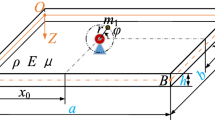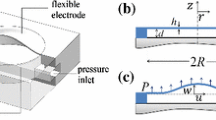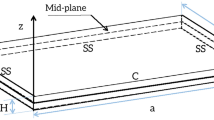Abstract
This study aims at understanding the mechanical behavior and static response of an electrically actuated micro-plate, considering the effects of different boundary conditions. The equations of motion of rectangular micro-plate-based micro-electro-mechanical systems are derived in terms of partial differential equations, exploiting the classical plate theory and von Kármán geometric nonlinearity. Two different boundary conditions are considered, i.e., simply supported and clamped with different in-plane conditions. The Galerkin procedure is employed to obtain a second-order nonlinear ordinary differential equation in time with quadratic, cubic, quartic, and higher nonlinear terms. The attention is mainly focused on the method of elimination of singularity in the electrostatic force. Therefore, two methods are implemented to treat singularity. By using the method of multiple time scales, the transient behavior of the system is obtained. Moreover, a discussion is made on how different design parameters affect the static response of micro-plates. In order to validate the obtained results, a numerical method by using Matlab®/Simulink® is employed.












Similar content being viewed by others
References
Younis MI (2001) Investigation of the mechanical behavior of microbeam-based MEMS devices. Dissertation, Virginia Tech
Zhao X, Abdel-Rahman EM, Nayfeh AH (2004) A reduced-order model for electrically actuated microplates. J Micromech Microeng 14(7):900
Zhao X (2004) Modeling and simulation of MEMS Devices. Dissertation, Virginia Tech
Younis MI, Abdel-Rahman EM, Nayfeh A (2003) A reduced-order model for electrically actuated microbeam-based MEMS. J Microelectromech Syst 12(5):672–680
Zhang XM, Chau FS, Quan C, Lam YL, Liu AQ (2001) A study of the static characteristics of a torsional micromirror. Sens Actuators, A 90(1–2):73–81
Younis MI (2004) Modeling and simulation of microelectromechanical systems in multi-physics fields. Dissertation, Virginia Tech
Varadan VK, Vinoy KJ, Jose KA (2003) RF MEMS and their applications. Wiley
Senturia SD (2002) Microsystem design. Kluwer Academic Publishers, New York, Boston
Zavracky PM, Majumder S, McGruer NE (1997) Micromechanical switches fabricated using nickel surface micromachining. J Microelectromech Syst 6(1):3–9
Yao ZJ, Chen S, Eshelman S, Denniston D, Goldsmith C (1999) Micromachined low-loss microwave switches. J Microelectromech Syst 8(2):129–134
Gretillat MA, Gretillat F, De Rooij NF (1999) Micromechanical relay with electrostatic actuation and metallic contacts. J Micromech Microeng 9(4):324
Gretillat MA, Yang YJ, Hung ES, Rabinovich V, Ananthasuresh GK, De Rooij NF, Senturia SD (1997) Nonlinear electromechanical behaviour of an electrostatic microrelay. In Proceedings of International Solid State Sensors and Actuators Conference (Transducers' 97), vol 2, pp 1141–1144
Castaner LM, Senturia SD (1999) Speed-energy optimization of electrostatic actuators based on pull-in. J Microelectromech Syst 8(3):290–298
Hung ES, Senturia SD (1999) Generating efficient dynamical models for microelectromechanical systems from a few finite-element simulation runs. J Microelectromech Syst 8(3):280–289
Cozma A, Puers R (1997) Electrostatic actuation as a self-testing method for silicon pressure sensors. Sens Actuators, A 60(1–3):32–36
Faris W, Abdel-Rahman E, Nayfeh A (2002) Mechanical behavior of an electrostatically actuated micropump. In 43rd AIAA/ASME/ASCE/AHS/ASC structures, structural dynamics, and materials conference, p 1303
Francais O, Dufour I (1998) Dynamic simulation of an electrostatic micropump with pull-in and hysteresis phenomena. Sens Actuators, A 70(1–2):56–60
Fletcher CAJ (1984) Computational galerkin methods. Computational galerkin methods. Springer, Berlin, Heidelberg, pp 72–85
Karim MF, Liu AQ, Alphones A, Yu AB (2006) A tunable bandstop filter via the capacitance change of micromachined switches. J Micromech Microeng 16(4):851
Yu AB, Liu AQ, Zhang QX, Alphones A, Hosseini HM (2006) Micromachined DC contact capacitive switch on low-resistivity silicon substrate. Sens Actuators, A 127(1):24–30
Huang JM, Liu AQ, Lu C, Ahn J (2003) Mechanical characterization of micromachined capacitive switches: design consideration and experimental verification. Sens Actuators, A 108(1–3):36–48
Mao JJ, Lu HM, Zhang W, Lai SK (2020) Vibrations of graphene nanoplatelet reinforced functionally gradient piezoelectric composite microplate based on nonlocal theory. Compos Struct 236:111813
Mao JJ, Zhang W, Lu HM (2020) Static and dynamic analyses of graphene-reinforced aluminium-based composite plate in thermal environment. Aerosp Sci Technol 107:106354
Kalhori H, Halkon B, Abbasnejad B, Li B, Shooshtari A (2021) Nonlinear vibration of an electrostatically excited capacitive microplate. Vibration engineering for a sustainable future. Springer, Cham, pp 3–9
Chia CY (1980) Nonlinear analysis of plates. McGraw-Hill International Book Company.
Reddy JN (2003) Mechanics of laminated composite plates and shells: theory and analysis. CRC Press
Elshenety A, El-Kholy EE, Abdou AF, Soliman M, Elhagry MM (2020) A flexible model for studying fringe field effect on parallel plate actuators. Journal of Electrical Systems and Information Technology 7(1):1–14
Nayfeh AH, Mook DT, Holmes P (1979) Nonlinear oscillations. John Wiley, New York
Nayfeh AH (2008) Perturbation methods. Wiley
Hosseini SM, Kalhori H, Shooshtari A, Mahmoodi SN (2014) Analytical solution for nonlinear forced response of a viscoelastic piezoelectric cantilever beam resting on a nonlinear elastic foundation to an external harmonic excitation. Compos B Eng 67:464–471
Hosseini SM, Shooshtari A, Kalhori H, Mahmoodi SN (2014) Nonlinear-forced vibrations of piezoelectrically actuated viscoelastic cantilevers. Nonlinear Dyn 78(1):571–583
Shooshtari A, Hoseini SM, Mahmoodi SN, Kalhori H (2012) Analytical solution for nonlinear free vibrations of viscoelastic microcantilevers covered with a piezoelectric layer. Smart Mater Struct 21(7):075015
Author information
Authors and Affiliations
Contributions
Conceptualization: [Hamed Kalhori, Alireza Shooshtari]; Methodology: [Hamed Kalhori, Alireza Shooshtari]; Formal analysis and investigation: [Hamed Kalhori, Shabnam Tashakori, Bing Li]; Writing - original draft preparation: [Hamed Kalhori]; Writing - review and editing: [Hamed Kalhori, Shabnam Tashakori, Bing Li].
Corresponding author
Ethics declarations
Conflict of interest
The authors declare that they have no known competing financial and non-financial interests or personal relationships that could have appeared to influence the work reported in this paper.
Appendix A
Appendix A
Constants of Eq. (27) for simply supported boundary conditions with zero tangential force and zero normal displacement are as follow
Constants of Eq. (28) for simply supported boundary conditions with zero tangential force and zero normal displacement are as follows
Rights and permissions
About this article
Cite this article
Kalhori, H., Shooshtari, A., Tashakori, S. et al. Mechanical behavior of a rectangular capacitive micro-plate subjected to an electrostatic load. Int. J. Dynam. Control 10, 1337–1348 (2022). https://doi.org/10.1007/s40435-021-00894-1
Received:
Revised:
Accepted:
Published:
Issue Date:
DOI: https://doi.org/10.1007/s40435-021-00894-1




